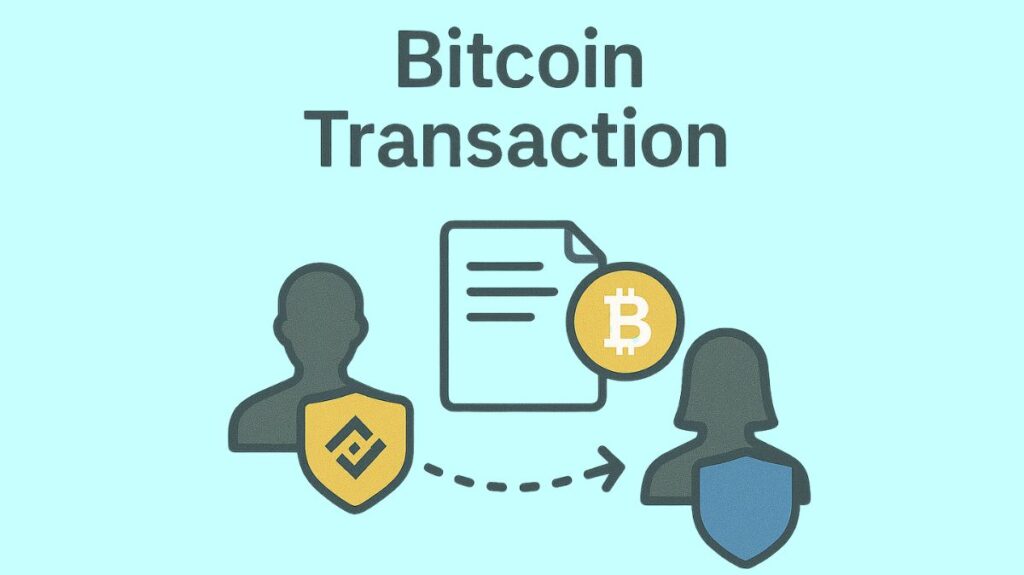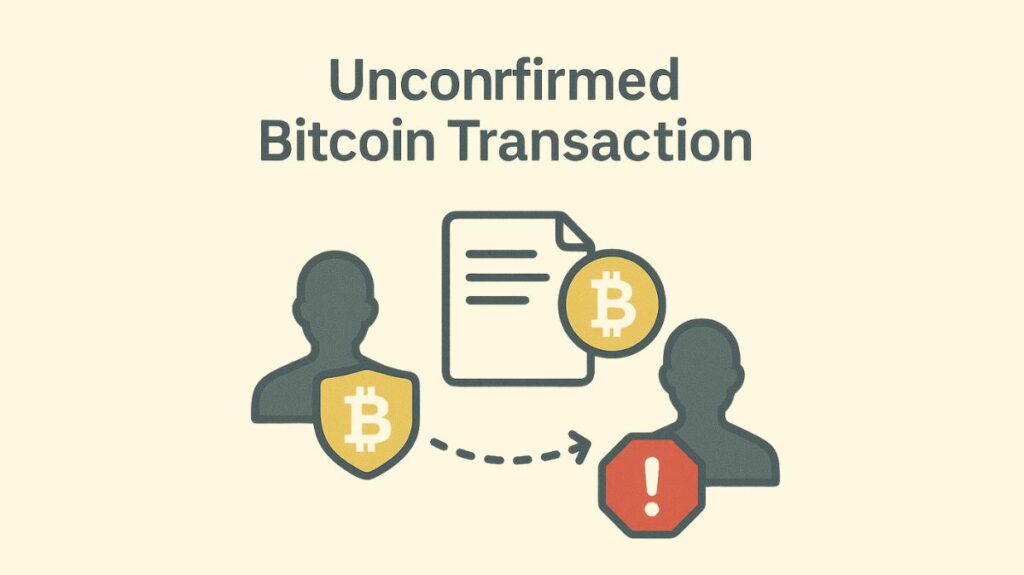Explore the key concepts behind unconfirmed Bitcoin transactions, including the mempool, miner incentives, and network congestion. Discover how these elements impact transaction speed and security.
Bitcoin transaction

Traditional bank transfers, which send money between accounts, are essentially different from Bitcoin transactions. A Bitcoin transaction, on the other hand, is a digitally signed communication that permits one or more senders to transfer ownership of a certain quantity of Bitcoin to one or more recipients. The blockchain, a public, secure, decentralized ledger, contains the records of these transactions. A bank or other middleman is not required for the full process to function.
Core Concepts: The UTXO Model and Cryptography
Grasp Bitcoin transactions requires a grasp of the Unspent Transaction Output (UTXO) mechanism.
UTXO Model: Think of your Bitcoin wallet as a collection of discrete digital currency “bills” with varying amounts rather than a single account balance. A UTXO is the quantity of Bitcoin that was received in a prior transaction but has not yet been used. Each time you receive Bitcoin, a new UTXO is assigned to your address and logged on the blockchain. All of the UTXOs that have been allocated to your addresses and that your private keys can spend add up to your total Bitcoin balance.
UTXOs are indivisible, meaning you have to spend the entire amount, just like actual cash. You have to use up your entire 5 BTC UTXO if you wish to transmit 2 BTC. It is required that any extra money from the input amount be specifically returned to the sender as “change” in another output. A bank account model, in which balances are only updated, is in contrast to this accounting technique.
Cryptographic Keys: Public-key cryptography is necessary to guarantee the integrity of Bitcoin transactions.
- Private Key: This number, like a password, is secret and only the owner knows it. It is important since it is used to digitally sign transactions, confirming that the sender is the legitimate owner of the Bitcoin and allowing related monies to be spent. Bitcoin cannot be recovered if your private key is lost.
- Public Key: The recipient can validate the sender’s digital signature by using the public key, which is recorded on the blockchain and is mathematically generated from the private key.
- Bitcoin Address: A user’s public key is used to generate this brief, alphanumeric string, which is utilized for security and conciseness. It’s common to use addresses and public keys interchangeably. A Bitcoin address (public key) can receive money from anyone, but only the associated private key can release it. P2PKH (beginning with ‘1’), P2SH (beginning with ‘2’), and Bech32 (beginning with ‘bc1’) are examples of distinct Bitcoin address types.
Structure of a Bitcoin Transaction
A data structure with the following components makes up a Bitcoin transaction:
Inputs: Your spending is specified by these UTXOs. The output (a UTXO) of a prior transaction that you hold is referenced by each input. A digital signature using the private key linked to the address that received the UTXO is required in order to approve spending these UTXOs. The evidence of ownership is this signature.
Outputs: These outline the destination of Bitcoin. Each output includes:
- How much Bitcoin is being sent?
- The money is locked to the recipient’s Bitcoin address, or public key hash, using a “locking script”
Transaction Fee: This represents the discrepancy between the sum of the inputs and of the outputs. This charge encourages miners to add your transaction to a block.
Bitcoin Transaction Lifecycle
Bitcoin exchange or sending requires the following steps:
Initiation and Creation: Using their wallet software, a user starts a transaction by entering the recipient’s address (public key) and the desired Bitcoin amount. After choosing the proper UTXOs as inputs and defining the outputs including a possible “change” output back to the sender in the event that the input value exceeds the intended transfer the wallet proceeds to construct the transaction.
Signing: The wallet software digitally signs the transaction using the sender’s private key. This signature validates the expenditure and attests to ownership.
Broadcasting: Next, the signed transaction is disseminated to the peer-to-peer Bitcoin network. The network’s nodes receive this transaction.
Verification: Every network node independently confirms the transaction. They verify the digital signature is accurate, the sender has enough money, and the inputs are legitimate UTXOs that haven’t been spent before. Preventing the “double-spending problem” is made easier by this check.
Mempool and Block Inclusion: A “mempool” of unconfirmed transactions is where the verified transaction is stored after it has been verified. Bitcoin miners choose which transactions to include in a new block by selecting them from the mempool.
Mining (Proof of Work): In order to add this new block to the blockchain, miners must solve a challenging cryptographic puzzle called Proof of Work (PoW). Usually, this Bitcoin transaction takes ten minutes or such. The first miner to solve the block adds it to the chain and broadcasts it.
Confirmation: It is deemed “confirmed” if a block containing the transaction has been mined and added to the blockchain. The transaction is regarded as irreversible and gets more secure as more blocks are piled on top of it. A higher level of assurance is often attained by users waiting for multiple confirmations (e.g., six).
Transaction Fees and Confirmation Time
Transaction Fees: Senders choose to include a fee in their transactions. Miners are rewarded with larger fees, which encourages them to prioritise transactions with higher costs, particularly when network congestion is high. Accordingly, a greater charge usually results in a quicker confirmation. The demand on the network may cause fees to change.
Confirmation Time: Transaction confirmation time is mostly determined by two factors:
- Transaction Fees: As was mentioned, processing times are accelerated by greater fees.
- Network Load: A high threshold for transaction activity can cause the mempool to get “jammed,” which slows down confirmation times for all ensuing transactions. Because of its Proof of Work consensus and 1MB block size, Bitcoin’s design limits its processing speed at between 3.3 and 7 transactions per second (tps).
Security and Transparency
Immutability: It is practically hard to change or reverse a transaction once it has been uploaded to the blockchain and included in a block since it is cryptographically connected to earlier blocks and requires recalculating all future hashes. By doing this, the record’s integrity is guaranteed.
Transparency and Pseudonymity: Since the Bitcoin blockchain is a public ledger, every transaction is available to all users, resulting in a complete and auditable transaction history. By not connecting their actual identities to their Bitcoin addresses, users can maintain their anonymity, although methods like as traffic analysis may be able to identify individuals.
Essentially, Bitcoin transactions “unlock” pre-existing UTXOs and produce new ones that are tied to the recipient’s address rather than “transferring” money in the conventional sense.
Unconfirmed Bitcoin Transaction

A transaction that has been broadcast to the Bitcoin network but has not yet been validated and added to a block on the blockchain by miners is known as an unconfirmed.
The status of a traditional bank transfer may be “pending” for some time before it is “cleared.” A Bitcoin transaction is sent out to the network of Bitcoin nodes when you start it from your wallet. Valid unconfirmed transactions are momentarily stored by these nodes in a waiting space known as the “mempool” (memory pool). A somewhat different version of the mempool is maintained by each node. From this mempool, miners select transactions to include to the subsequent block they attempt to mine. The confirmation of your transaction occurs when a miner successfully locates a new block that contains your transaction, adds that block to the blockchain, and the network allows it.
